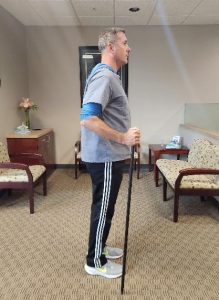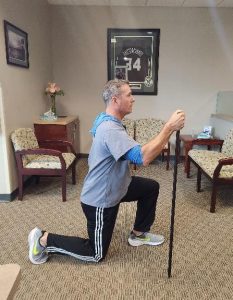Exercise of the Week: Step-Back Lunge

Luke Lewitzke
Certified A.C.E. (American Counsel on Exercise) Personal Trainer
Weight and Lifestyle Management Specialist
The Step-back Lunge, or Reverse Lunge, is going to primarily work your glutes, hamstrings, and quadriceps. Your calves will also work to help stabilize your body as your back foot hits the ground. While performing a Step-back Lunge may intuitively seem harder than stepping forward, it is actually easier on your body as it takes the forward slide off of the front knee, which is nice if you are dealing with a little knee discomfort.
Performing the Step-Back Lunge
- For this exercise, the key is to step back, not forward, so that your front knee doesn’t slide too far forward.
- Maintaining a tall posture through your spine, step back with your right leg onto the balls of your right toes.
- Bend both knees until the right knee touches the floor. Note that the right knee should be directly under the right hip.
- Brace your midsection and remain tall as you stand back up, bringing your feet together in one smooth motion.
- Perform 5-10 repetitions on each leg.
- Rest for 1 minute and then repeat the exercise.

Regressions
Supported Step-Back Lunge


- Hold onto a dowel or a chair or even the countertop to assist with balance on the side of the leg that you are going to step back with.
- Maintain a tall posture, brace the core, and step-back into the lunge position as you lower your knee down to the floor.
- Make sure that you step far enough back so that your knee is located directly below your hip.
- Pause for a moment, brace your core and push down on the dowel or into the chair or countertop to create tension.
- Maintain a tall posture and keep the tension just created, and stand back up, bringing your feet together in one smooth motion.
- Perform 5-10 repetitions on each leg.
- Rest for 1 minute and then repeat the exercise.
Contraindications
- Don’t perform the Step-back Lunge if you get a sharp pain in either the back or front knee.
- Regress to the supported Step-back Lunge if you can not safely control the movement all the way down to the floor.
- Regress to the supported Step-back Lunge if you collapse or fold forward at the waist as you try to stand back up.



